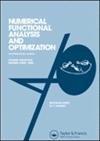Analysis and Numerical Approach of a Coupled Thermo-Electro-Mechanical System for Nonlinear Hencky-Type Materials with Nonlocal Coulomb’s Friction
IF 1.4
4区 数学
Q2 MATHEMATICS, APPLIED
Numerical Functional Analysis and Optimization
Pub Date : 2023-05-19
DOI:10.1080/01630563.2023.2212496
引用次数: 0
Abstract
Abstract The effects of an included temperature field in the contact process between a piezoelectric body and a rigid foundation with thermal and electrical conductivity are discussed. The constitutive relation of the material is assumed to be thermo-electro-elastic and involves the nonlinear elastic constitutive Hencky’s law. The frictional contact is modeled with Signorini’s conditions, the regularized Coulomb law, and the regularized electrical and thermal conductivity conditions. The resulting thermo-electromechanical model includes the temperature field as an additional state variable to take into account thermal effects alongside with those of the piezoelectric. The existence of the unique weak solution to the problem is established by using Schauder’s fixed point theorem combined with arguments from the theory of variational inequalities involving nonlinear strongly monotone Lipschitz continuous operators. A successive iteration technique to solve the problem numerically is proposed, and its convergence is established. A variant of the Augmented Lagrangian, the so-called Alternating Direction Method of multipliers (ADMM), is used to decompose the original problem into two sub-problems, solve them sequentially and update the dual variables at each iteration. The influence of the thermal boundary condition on the behavior of contact forces and electrical potential is shown through graphical illustrations.具有非局部库仑摩擦的非线性henky型材料热-电-机械耦合系统的分析与数值方法
讨论了含温场对压电体与具有导热性和导电性的刚性基础接触过程的影响。假定材料的本构关系为热-电弹性关系,涉及非线性弹性本构henky定律。摩擦接触用sigorini条件、正则化库仑定律和正则化电导和导热条件进行建模。所得到的热-机电模型包括温度场作为一个额外的状态变量,以考虑热效应和压电效应。利用Schauder不动点定理,结合涉及非线性强单调Lipschitz连续算子的变分不等式理论的论证,证明了该问题弱解的存在性。提出了一种逐次迭代的数值求解方法,并证明了该方法的收敛性。增广拉格朗日的一种变体,即所谓的乘数交替方向法(ADMM),它将原问题分解为两个子问题,依次求解,并在每次迭代时更新对偶变量。通过图解说明了热边界条件对接触力和电势行为的影响。
本文章由计算机程序翻译,如有差异,请以英文原文为准。
求助全文
约1分钟内获得全文
求助全文
来源期刊
CiteScore
2.40
自引率
8.30%
发文量
74
审稿时长
6-12 weeks
期刊介绍:
Numerical Functional Analysis and Optimization is a journal aimed at development and applications of functional analysis and operator-theoretic methods in numerical analysis, optimization and approximation theory, control theory, signal and image processing, inverse and ill-posed problems, applied and computational harmonic analysis, operator equations, and nonlinear functional analysis. Not all high-quality papers within the union of these fields are within the scope of NFAO. Generalizations and abstractions that significantly advance their fields and reinforce the concrete by providing new insight and important results for problems arising from applications are welcome. On the other hand, technical generalizations for their own sake with window dressing about applications, or variants of known results and algorithms, are not suitable for this journal.
Numerical Functional Analysis and Optimization publishes about 70 papers per year. It is our current policy to limit consideration to one submitted paper by any author/co-author per two consecutive years. Exception will be made for seminal papers.

 求助内容:
求助内容: 应助结果提醒方式:
应助结果提醒方式:


